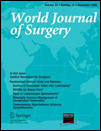Endoscopic Parathyroidectomy: Why and When?
Abstract
Background
In recent years, several new minimally invasive techniques for parathyroidectomy (MIP) have been developed. There was a rapid worldwide acceptance of mini-open procedures by most surgeons. However, the use of an endoscope remains debatable. This study was designed to determine the role of preoperative imaging studies in the decision-making for using an endoscope during MIP.
Methods
All patients with sporadic primary hyperparathyroidism (PHPT) and candidate for MIP underwent localizing studies. MIP was proposed only for patients in whom a single adenoma was localized by both ultrasonography and sestamibi scanning. Three locations were described: (1) posterior to the two superior thirds of the thyroid lobe; (2) at the level of or below the inferior pole of the thyroid lobe but in a plane posterior to it; (3) at the level of or below the tip of the inferior pole of the thyroid lobe but in a superficial plane. In locations 1 and 2, the nerve was considered to be at risk and an endoscopic lateral approach was indicated. In location 3, a mini-open approach was indicated.
Results
Of the 165 patients operated on for PHPT in 2006, 86 underwent MIP. According to the results of imaging studies, 39 patients presented an adenoma in location 1, 21 in location 2, and 26 in location 3. In locations 1 and 2, 59 patients (1 false-positive) had an adenoma that was located posteriorly, in close proximity to the nerve; all were cured. In location 3, 25 patients (1 false-positive) presented an inferior parathyroid adenoma superficially located; all were cured. There was no transient or permanent laryngeal nerve palsy.
Conclusions
In patients who are candidates for MIP, we recommend the use of the endoscope for the resection of parathyroid adenomas that are located deeply in the neck.




